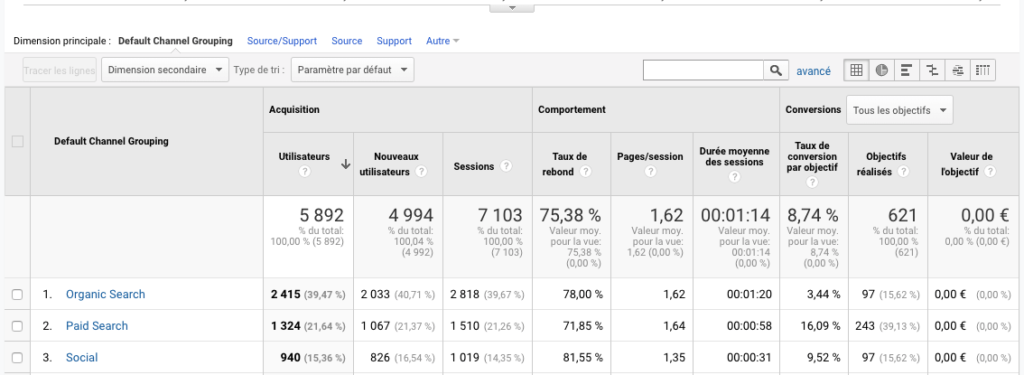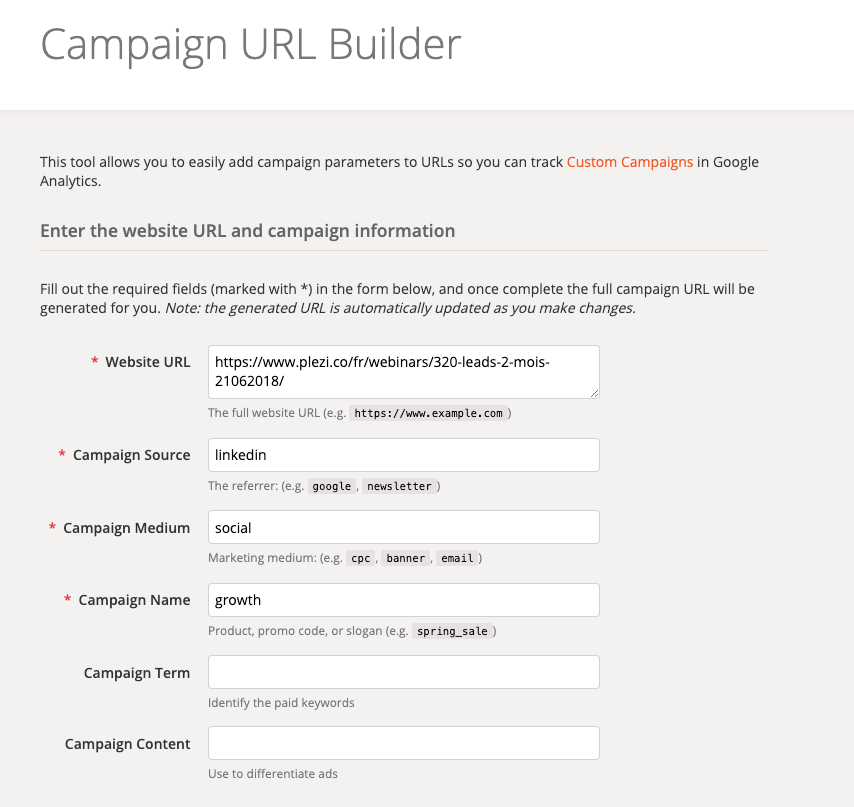Urchin Tracking Module (UTM) parameters are like a guiding light for digital marketers. If you’re not using them, you’ll be left in the dark about the success of your marketing campaigns.
Also called codes or tags, UTM parameters help you track where the traffic to your website comes from and measure the results of marketing campaigns. Using them is essential if you want to know where your customers come from. They’re key to digital marketing, and the not-so-secret ingredient of most marketing software.
But while they’re one of the first things a digital marketer should learn how to use, you won’t find two marketers who use them in the same way.
In this post, we’ll look at how to use UTM parameters, some of the challenges involved, and check that you’re using them to their full potential.
We’ve also produced a free tool to let you easily generate shortened links that include UTM codes, saving you several hours each week.
- How URLs are structured
- Using UTM parameters to track marketing campaigns
- The 5 different UTM parameters
- How to read UTM tags in Google Analytics
- How to create URLS with UTM tags
- UTM best practices & FAQs

How URLs are structured
Before we look at UTM parameters, we need to start by looking at URLs. The acronym URL stands for Uniform Resource Locator. Every single piece of content on the internet has its own unique URL address.
To understand how URLs work, it might help to compare them with real addresses and how things get sent to them.
To start with, you have the Hypertext Transfer Protocol or HTTP. All you really need to know is that this protocol enables things to be sent to a particular address. It’s a bit like the Royal Mail or a courier company. There are two basic variants of this protocol, HTTP, and the more secure HTTPS. Most websites now use the HTTPS protocol.
A website domain name is like the city in which you live. For example, in our case the city is “plezi.co”.
Many people think that the full address of a website (or the name of the city) is www.domainname.com. But that’s not the case. The “www” element is not actually necessary. It’s a naming convention that comes from the early days of the internet.
The “www” element, which stands for World Wide Web, is actually what is known as a subdomain. It’s like a specific borough or area within the city. And just like a real city, a website domain can include a number of subdomains.
On the Plezi website, for example, we use:
- “www” as our main subdomain
- “content” is our subdomain for landing pages (created using Plezi)
- “app” is the subdomain for the Plezi software itself
Subdomains are also commonly used to manage a multilingual website. At Plezi we use categories for this, but the pros and cons of each approach is probably the topic of another blog post!
The categories that we’ve just mentioned are like the different streets in every borough.
On the Plezi website, for example, you’ll find all our webinars at the URL:
https://www.plezi.co/en/webinars/
Here, “webinars” is the category. The URLs of our webinars therefore all include the category “/webinars/”, for example:
https://www.plezi.co/en/webinars/digital-first-b2b-marketing-for-2022/
The end of a URL corresponds to a specific webpage, which is like a house or building on a given street.
So, the URL of any piece of content is made up of all the things we’ve just talked about:
- protocol
- subdomain
- domain
- category or categories
- webpage
You can also add what are called parameters to the end of URLs to get statistics on the number of people that visit certain webpages. Now let’s take a look at how those parameters work.
Using UTM parameters to track marketing campaigns
How UTM parameters work
UTM parameters are codes or tags that are added to URLs to track the different sources of website traffic. Most web marketing tools now make use of use these.
Urchin Tracking Module (UTM) parameters were originally created by Urchin Software Corporation. They were acquired by Google in 2005, becoming the basis of Google Analytics.
A typical URL that includes UTM parameters looks something like this:
https://www.plezi.co/en/webinars/digital-first-b2b-marketing-for-2022/
You should note that all of the information in the URL after the question mark doesn’t affect how a webpage is displayed to users.
Because UTM parameters track the source of website traffic, they should be removed or changed when you reshare content on different channels.
For example, you might send an email newsletter to leads which includes UTM parameters for this channel. If you want to share this URL on social media and you leave the UTM tags as they are, the analytics of your website will interpret all social media traffic as coming from the email newsletter.
There are several different UTM parameters, and each provides different information. They are separated in the URL using the “&” symbol. All UTMs tags used also should be preceded by a single question mark.
Why you should use UTM parameters
UTM parameters are designed to help you track the sources of traffic to your website.
The ins and outs of how UTM parameters work can be quite technical. The main thing you need to know is that when you share a link on an external channel, UTM tags will help you track traffic from that channel.
For example, say you send an email to leads that contains several links, but you don’t add UTM tags to these. People who click on these links will be counted by your analytics programme as direct traffic to your website instead of coming from your email.
Similarly, the only way to know if your social media traffic comes from LinkedIn, Facebook, or Twitter is to add UTM tags to the URLs you share on these networks.
UTM parameters are also key to understanding marketing attribution. This tells you which channels are driving your sales. This isn’t a major issue for most SMEs, but it becomes increasingly important as your marketing organization becomes more complex.
The 5 different UTM parameters
There are 5 different UTM parameters which let you track a number of different aspects of any marketing campaign. Three of these (utm_campaign, utm_medium, and utm_source) are required information.
There are a number of different ways in which you can use UTM parameters. That usually means you need to use several different tags in order to accurately track traffic to your website.
utm_campaign
The utm_campaign parameter is used to designate the marketing campaign or action in the context of which a link is sent.
For example, if you take part in a trade show you can track the outcome of your actions by using this as a utm_campaign tag across all channels.
You can also use the same utm_campaign tag for things that occur regularly over a period of time. For example, you can use the same tag to track regular posts to social media by the person who manages your social media accounts.
utm_medium
The utm_medium parameter tracks the marketing channel that traffic comes from. To go back to our example of a real city, utm_medium tells you how traffic came to the city (e.g., by train, car, or plane).
These can be written in different ways and that can make it difficult for analytics tools to aggregate data. That’s why it’s a good idea to use established naming conventions. Here’s a partial list of channel categories and the way that the utm_medium parameter could be written:
- Social media: social, social-network, social-media, sm
- Email: email
- Paid campaigns (cost per click): cpc, ppc, paidsearch, cpa
- Display campaigns (banner advertising): display, cpm, banner
- Affiliate links (B2B partners): affiliate, partner
utm_source
As you might suspect, the utm_source parameter is used to track the ultimate source of web traffic. It should be used in conjunction with utm_medium to give you a good understanding of where traffic to your website comes from.
The utm_source parameter identifies which website sent you traffic. To continue with our real-world example, it tells you where the trains, cars, and planes have come from.
For example, your paid advertising campaigns will all use the same utm_medium tag, but the utm_source tag will change depending on the website involved:
- utm_medium=cpc&utm_source=linkedin
- utm_medium=cpc&utm_source=twitter
- utm_medium=cpc&utm_source=facebook
utm_term
The utm_term parameter identifies search terms or keywords. This gives you information about a marketing campaign at the granular level.
You can also group messages, for example, according to their personas by using the buyer persona as the utm_term tag.
utm_content
The utm_content tag is used to identify the content or element clicked on that brought traffic to your website. For example, if you send an email with one link in the email signature and another on a button, you can use both “signature” and “button” as utm_content tags.
Of course, the content you are sending traffic to shouldn’t be added as a utm_content tag.
These tags can also be used for A/B testing. Let’s say you create two different web banners to promote a tool that helps visitors create an editorial calendar. You can create separate utm_content tags for each banner, say “editorialcalendar” and “contentcalendar”, and test which banner sends you the most traffic.
How to read UTM tags in Google Analytics
Google Analytics makes full use of UTM parameters, but you won’t necessarily see them in your dashboard. When you look at the pages visited on your website in Google Analytics, the application removes the associated UTM tags from this view. It does this in order to show them elsewhere (e.g., as filters).
At Plezi, our preferred way of looking at website traffic is by going to:
Acquisition > All traffic > Channels
This is the same as looking at traffic by the utm_medium tag, as in the image below.
In this same view, you can also see statistics for acquisition, behaviour, and conversion. In the example above, you can see that while organic search attracts nearly 3 times as much traffic as social media over this period, the two channels have resulted in the same number of conversions.
You can also see that there are different filters available under Primary Dimension. These let you look at the different UTM parameters, including the combination of Source / Medium.
To display statistics by utm_campaign, utm_term, or utm_content tags, simply click on Other and then select the appropriate filter in “More dimensions”.
You can use these filters in almost any view in Google Analytics.
Now let’s take a look at how you can create URLs with UTM parameters.
How to create URLS with UTM tags
Using Google URL Builder
It’s certainly possible to manually type URLs that contain UTM tags, but it will probably take you a lot of time!
Luckily, Google has created a tool that makes it easier to write URLs with UTM parameters. You simply paste in your content URL, indicate the UTM tags you want, and it generates a correctly formatted URL with tags for you.
This is a useful tool, but it doesn’t let you track how different UTM parameters might change over time. That’s why at Plezi we’ve created a free tool on Google sheets to generate shortened URLs with UTM tags. This lets you create and directly track all your URLS with UTM tags.
Creating and reading UTM tags in Plezi
Using marketing automation software like Plezi, you don’t have to worry about tracking UTM tags every time you share a link. Our tool does this for you by following best industry practices.
For example, you can publish content to the social media profiles of your sales team directly in Plezi. You simply select the content URL and the social media profiles you want to publish it to.
The software will then automatically add the “social” utm_medium tag and a utm_source tag for the social network you are posting to, e.g., “linkedIn” or “twitter”.
Our software reads UTM parameters in the same way as Google Analytics. The difference is that you can see the UTM tags for each of your leads. This lets you see how they initially arrived at your website and how they come back to it.
By integrating Plezi with your CRM, you can even analyse the source of new customers. This will let you see the return on investment of all your sources of traffic.
Now you’ve got everything you need to use UTM parameters like a pro. How do you use UTM parameters? What different utm_medium tags do you use? Why not tell us in the comments below?
UTM best practices & FAQs
Can UTM tags be used with internal links
No, UTM parameters shouldn’t be used with internal links on your website. They are designed to track sources of traffic to your website, not the parts of your website that help convert leads.
To track internal links, use other tags or tracking by event in Google Analytics. If you add UTM tags to internal links, you’ll obscure the original source of website traffic.
Are UTM tags case sensitive?
Yes, UTM parameters are case sensitive. It’s a good idea to choose a naming convention and then stick to it. We recommend:
– No capital letters.
– No spaces.
Do all tools use the same UTM naming conventions?
Unfortunately, no. Even Google’s own documentation is not particularly clear and leaves room for interpretation. That means that each marketer will probably have their own way of doing things. As long as you’re consistent in the naming conventions you use, it won’t matter that much. Being consistent with the UTM tags you use is the only way to be able to track them and make use of the data they provide.
In addition, some analytics tools use a different system of tags altogether and don’t use UTM parameters at all.
One of the main risks is wanting to track too many things. You can end up adding UTM tags everywhere, for example naming each button and piece of content with utm_content and utm_term tags. But if you can’t make use of the data, there’s no need to waste your time tracking it.
Where are UTM tags placed in the URL?
A UTM parameter is always added to the end of a URL, as we explained above in the section on how UTM parameters work. They should be used with all links that you share on external channels designed to send traffic to your website.
Should UTM tags always be used with web advertising?
Yes. As soon as you spend money on advertising, it’s vital to add UTM parameters to track the performance of these campaigns. For example, they will let you segment leads almost endlessly, and track them back to the ad they clicked on.







